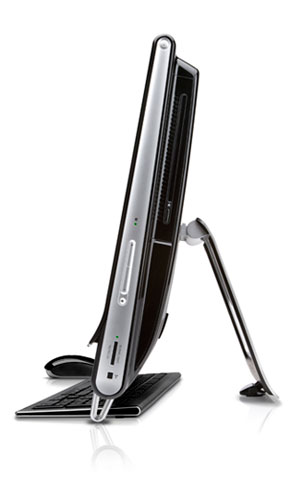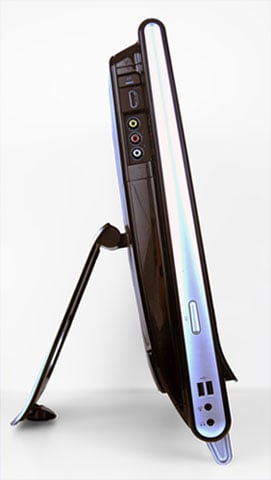HP TouchSmart 600 All-In-One PC Review
System Design
 Viewing the TouchSmart 600 from the front, it’s hard to tell that you are looking at a desktop PC--the roughly 1.5-inch thick bezel and front-mounted stereo speakers give the deceptive appearance that you are looking at merely a monitor. If you wanted, you could even wall-mount the system. The only other features located on the front of the system are a webcam and stereo mic holes in the center of the top bezel, the HP TouchSmart button located on the lower-right corner of the bottom bezel (pressing this powers up the system or launches the HP TouchSmart suite if the system is running), and the HP Ambient Light which illuminates the space directly beneath the system. The Ambient Light is hidden behind the system’s bottom bezel (you can control its color and brightness via software).
Viewing the TouchSmart 600 from the front, it’s hard to tell that you are looking at a desktop PC--the roughly 1.5-inch thick bezel and front-mounted stereo speakers give the deceptive appearance that you are looking at merely a monitor. If you wanted, you could even wall-mount the system. The only other features located on the front of the system are a webcam and stereo mic holes in the center of the top bezel, the HP TouchSmart button located on the lower-right corner of the bottom bezel (pressing this powers up the system or launches the HP TouchSmart suite if the system is running), and the HP Ambient Light which illuminates the space directly beneath the system. The Ambient Light is hidden behind the system’s bottom bezel (you can control its color and brightness via software).The front bezel is made of glossy black plastic with a silver edge separating the bezel from the speakers--HP calls this “piano-black finish with chrome accents.” Other than the sides of the unit, which are silver, the rest of the system is all glossy black--including its backside. The 23-inch display is glossy as well, has a 16:9 aspect ratio, and a native resolution of 1920x1080. The TouchSmart 600 is 13-inches wide and 17.75-inches high. Not including the stand, the system is 2.83-inches thick; the stand attaches to a hinge on the back of the system and opens up to between 5 and 40-degrees.
The backside of the system is also very sparse--in fact, other the stand, all that you’ll find on the back of the system are the power connector, a single USB port, security lock slot, and a small lever located behind the webcam for controlling the tilt angle of the webcam. Keeping with its minimalist appearance there isn’t a whole lot located on the right side of the system either: From top to bottom, the TouchSmart 600’s right side houses the power button, slot-loading Blu-ray drive, hard disk activity light, volume controls, and memory-card reader.
A few more ports can be found on the left side of the system: HDMI and Composite Video/audio inputs (yes, inputs--more on this in a moment); Ambient Light button, two USB 2.0 ports, and mic and headphone jacks. The purpose of the video/audio input ports is so that you can connect a game console to the TouchSmart 600 in order to take advantage of the TouchSmart’s true 1080p display--an A/V source button located above the HDMI port cycles through the different inputs.
If you’ve been paying close attention to list of ports mentioned so far, you’re probably wondering where the rest of the TouchSmart 600’s ports are hiding--and hiding is indeed what they are doing. Popping off a connector cover on the left side of the system reveals the remainder the system’s connections: three more USB 2.0 ports, Gigabit Ethernet, digital audio out (SPDIF), (analog) audio out, coaxial TV input, S-Video input, audio-in, and IR-out (which is used with the included IR blaster cable). A cable clip and small cut-out allow you route all the cables in such a way that you can reattach the connector cover once you’ve got everything plugged in.
A total of six USB ports is not a lot but enough for most of you we're sure, though you lose one of them out of the box as the USB port on the back of the system comes already occupied by the USB dongle for the wireless keyboard and mouse. The TouchSmart 600 also comes with a remote, microfiber cloth for cleaning the display, an audio splitter cable (stereo RCA to 3.5mm), and a detailed 70-page user guide. You’ll have to create your own recovery discs, and if you plan on using the TouchSmart 600’s built-in TV tuner for watching over-the-air broadcasts, you’ll need to supply your own antenna. As with most all-in-one PC designs, the TouchSmart 600 is not upgradeable--none of the internal components (such as memory or hard drive) are user-accessible.
Just as the TouchSmart 600 is HP’s third iteration of the TouchSmart series, the specific unit we reviewed was actually the third TouchSmart 600 system HP sent us. The first system appeared to run fine, but once we started using the touchscreen interface, we noticed that where the system was sensing input was not exactly where we were placing our fingers--something was not quite right with the touch sensors. HP quickly arranged for us to send that unit back and get a replacement unit on its way to us. HP was also quick to point out that “physical problems with the optical sensors is covered by the warranty, so should this ever happen to a customer, HP warranty would replace it.” The second replacement unit did not survive shipping, as the right corner was smashed in, thanks to some rough handling by Fed Ex. We didn’t even attempt to power it on--we boxed it back up and sent it back to HP. Finally, the third system arrived unscathed and operated as expected.













